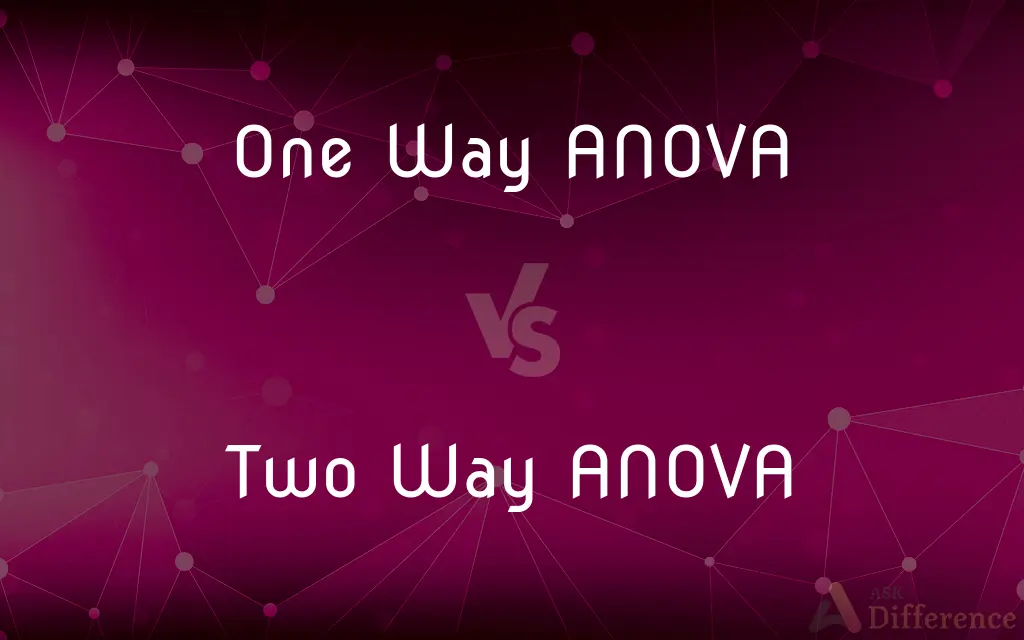One Way ANOVA vs. Two Way ANOVA — What's the Difference?
By Tayyaba Rehman — Published on December 18, 2023
One Way ANOVA tests differences between groups based on one factor; Two Way ANOVA tests based on two factors.

Difference Between One Way ANOVA and Two Way ANOVA
Table of Contents
ADVERTISEMENT
Key Differences
One Way ANOVA is a statistical method that tests the differences between the means of three or more groups based on one independent variable or factor. In contrast, Two Way ANOVA is used when there are two independent variables or factors. This difference in factors makes One Way ANOVA and Two Way ANOVA distinct in their applications and results.
The primary purpose of One Way ANOVA is to see if there is any statistically significant difference between the means of these groups due to the single factor. Two Way ANOVA, on the other hand, not only tests for the main effects of each of the two factors but also checks for any possible interaction between these factors.
When conducting a One Way ANOVA, the researcher is mainly interested in determining if changes in the single independent variable have a significant effect on the dependent variable. With Two Way ANOVA, the interest lies in discerning the individual and combined effects of the two independent variables on the dependent variable.
In summary, while One Way ANOVA deals with a singular factor and its effect on a dependent variable, Two Way ANOVA delves deeper, exploring the effects and interactions of two distinct factors on a dependent variable. The choice between One Way ANOVA and Two Way ANOVA hinges on the number of independent variables or factors in the study.
Comparison Chart
Number of Independent Variables
One
Two
ADVERTISEMENT
Purpose
Tests for differences based on one factor
Tests for differences and interactions based on two factors
Interaction Effects
Not applicable
Can test for interactions between the two factors
Analysis Complexity
Relatively simpler
More complex due to additional factor and interactions
Examples
Comparing scores of students from three schools
Comparing scores based on schools and teaching methods
Compare with Definitions
One Way ANOVA
A statistical method for analyzing one independent variable's effect.
Using One Way ANOVA, we assessed the impact of different materials on product strength.
Two Way ANOVA
Explores variances among group means for two distinct variables.
Two Way ANOVA was employed to study the variances between job type and educational level on salary.
One Way ANOVA
Determines if one factor significantly affects a dependent variable.
A One Way ANOVA indicated that brand choice significantly influenced customer satisfaction.
Two Way ANOVA
Assesses differences based on two independent variables.
A Two Way ANOVA was used to analyze the effects of age and gender on test scores.
One Way ANOVA
Tests differences between group means based on one factor.
A One Way ANOVA was used to compare the effectiveness of three different diets.
Two Way ANOVA
Tests for main effects and interactions of two factors.
Through Two Way ANOVA, we tested for interactions between diet and exercise regimens.
One Way ANOVA
Assesses variance among group means for a single factor.
One Way ANOVA revealed significant variance among the group means for study methods.
Two Way ANOVA
Assesses the individual and combined influences of two factors.
Two Way ANOVA assessed the impact of teaching method and classroom size on student performance.
One Way ANOVA
Tests if there's a significant difference in means due to one variable.
The study utilized One Way ANOVA to test if age groups differed significantly in buying patterns.
Two Way ANOVA
Analyzes the combined effects of two different factors.
The Two Way ANOVA results showed a combined effect of light and soil type on plant growth.
Common Curiosities
Why might a researcher use Two Way ANOVA?
A researcher might use Two Way ANOVA to analyze the individual and combined effects of two independent variables on a dependent variable.
What is the primary purpose of One Way ANOVA?
One Way ANOVA tests the differences between the means of three or more groups based on one factor.
Can One Way ANOVA test for interactions?
No, One Way ANOVA does not test for interactions as it only considers one factor.
Is Two Way ANOVA more complex than One Way ANOVA?
Yes, Two Way ANOVA is generally more complex due to the additional factor and potential interactions.
Can I use Two Way ANOVA for one factor?
While technically possible, it's more appropriate to use One Way ANOVA for a single factor.
Can One Way ANOVA be used for two factors?
No, One Way ANOVA is designed to test differences based on a single factor. For two factors, Two Way ANOVA is appropriate.
How many groups can One Way ANOVA compare?
One Way ANOVA can compare three or more groups.
Is the output of Two Way ANOVA more detailed than One Way ANOVA?
Generally, yes, because Two Way ANOVA provides results for two main effects and their potential interaction.
How does Two Way ANOVA differ from One Way ANOVA?
Two Way ANOVA tests for differences and interactions based on two factors, while One Way ANOVA focuses on one factor.
Do both ANOVAs determine statistical significance?
Yes, both One Way ANOVA and Two Way ANOVA are used to determine if differences between groups are statistically significant.
Does Two Way ANOVA always test for interactions?
Two Way ANOVA can test for interactions, but whether it does depends on the design and aim of the analysis.
When is it inappropriate to use One Way ANOVA?
When there are two independent variables or factors in a study, One Way ANOVA is inappropriate.
Why is Two Way ANOVA's interaction effect important?
It indicates if the effect of one factor depends on the level of the other factor.
Are the assumptions for One Way ANOVA and Two Way ANOVA the same?
They share several assumptions, but Two Way ANOVA has additional considerations due to the extra factor and interactions.
Does Two Way ANOVA require more data than One Way ANOVA?
Generally, yes, because Two Way ANOVA involves analyzing effects of two independent variables.
Share Your Discovery

Previous Comparison
NADH vs. FADH2
Next Comparison
Markovnikov Rule vs. Anti Markovnikov RuleAuthor Spotlight
Written by
Tayyaba RehmanTayyaba Rehman is a distinguished writer, currently serving as a primary contributor to askdifference.com. As a researcher in semantics and etymology, Tayyaba's passion for the complexity of languages and their distinctions has found a perfect home on the platform. Tayyaba delves into the intricacies of language, distinguishing between commonly confused words and phrases, thereby providing clarity for readers worldwide.














































